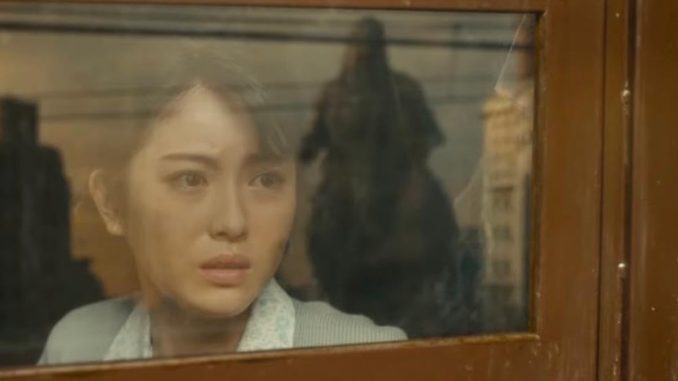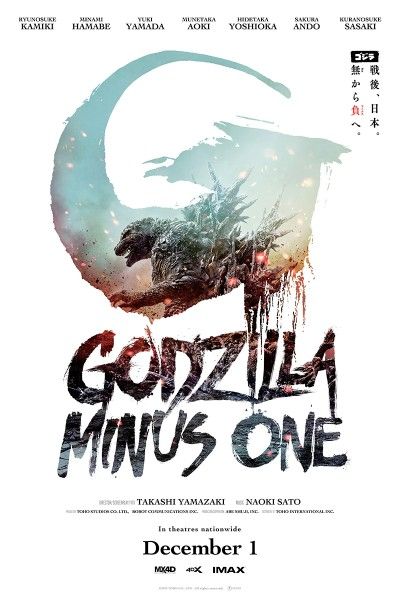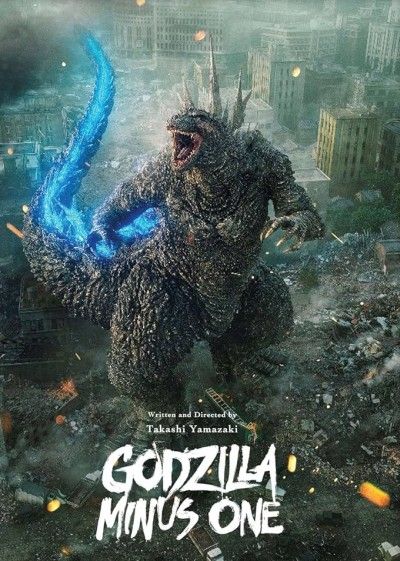
Rating: A/A+
Dir: Takashi Yamazaki
Star: Ryunosuke Kamiki, Hidetaka Yoshioka, Minami Hamabe, Sakura Ando
I finally get to see a Japanese Godzilla movie on the big screen. You never forget your first time, and what an experience it was. Not least because we went IMAX for this one. Been a very long while since we were there. I think it was probably for Avatar, and Chris spent the bulk of the film staring at the back of the seat in front. That was the last time we saw a 3D film. Anyway, had forgotten how big the screens are. “Row F will be far enough back,” we thought, only to find ourselves looking up at about 80% of the screen. But it was a perfect location, for reasons I’ll get to.
One impressive point was the non-kaiju plot. This was likely the best in the franchise, to the point it could have been worth watching without any city stomping at all. Kōichi Shikishima (Kamiki) is a failed kamikaze pilot – insert your own joke there – who is now plagued by guilt, believing he failed his family and his country. Returning to a devastated Tokyo, he befriends Noriko (Hanabe) and her foster daughter, and they try to make their way in post-war Japan, with Kōichi struggling to find meaning in life, and a reason to go on. This comes in the form of a giant, radioactive lizard. What are the odds? For he crosses paths with Godzilla, both during the war – when his inaction causes the death of fellow soldiers – and after, when he’s working on mine clearance.
 This all adds to his trauma-based PTSD, and it almost begins to feel as if he’s being stalked by the creature. Things become personal for him, like Captain Ahab and Moby Dick, with Godzilla haunting Kōichi’s dreams. Of course, it isn’t. Godzilla doesn’t know he exists, and destroys Tokyo. Since America is otherwise engaged, rattling its sabres with Russia, and the Japanese military is defanged after the war, it’s up to a rag-tag bag of civilians to figure out a way to stop the carnage. Actually, several ways, courtesy of scientist Kenji Noda (Yoshioka). Y’know, just in case the first one doesn’t work. Might this provide the opportunity for heroic sacrifice and redemption Kōichi has been seeking?
This all adds to his trauma-based PTSD, and it almost begins to feel as if he’s being stalked by the creature. Things become personal for him, like Captain Ahab and Moby Dick, with Godzilla haunting Kōichi’s dreams. Of course, it isn’t. Godzilla doesn’t know he exists, and destroys Tokyo. Since America is otherwise engaged, rattling its sabres with Russia, and the Japanese military is defanged after the war, it’s up to a rag-tag bag of civilians to figure out a way to stop the carnage. Actually, several ways, courtesy of scientist Kenji Noda (Yoshioka). Y’know, just in case the first one doesn’t work. Might this provide the opportunity for heroic sacrifice and redemption Kōichi has been seeking?
All of which is, as far as I am concerned, a side-dish. The main course is the big G, and boy, does this deliver. From the relatively fun-sized version we see during the last days of WW2, it’s clear this incarnation is not a friend to mankind, and is in maximum devastation mode. It’s an angry Godzilla. When power-ups and size multipliers are unlocked, due to the nuclear testing, it becomes basically unstoppable, quickly regenerating any damage inflicted by puny humans and their feeble weapons. I was left wondering how the hell Noda could come up with a viable scheme to defeat it. The solution turns out to imaginative and clever enough to pass muster, in a “It’s so crazy, it just might work” kinda way.
There’s a sense of escalation here, with each appearance by Godzilla being more awe-inspiring and terrible. It’s not just faffing about with fog and reaction shots here. We likely reach Peak G during the attack on Ginza. This is where sitting five rows from the front in an IMAX screen truly paid off, since it put us at ground zero for the destruction, Godzilla literally towering over us. Then it unleashes the atomic breath, and we reach a whole new level. This isn’t just the heat-ray thing from previous versions. It’s more like pure, undiluted nuclear armageddon. By the time Godzilla had got bored and returned to the sea, my jaw was genuinely hanging open. Bonus points for Naoki Satō’s score, which fuses the theme we know and love, with modern elements, reminiscent of Ryuichi Sakamoto score for Wings of Honnêamise on occasion.
Especially considering the budget for this was a mere $15 million, it looks startlingly good, and you wonder how Hollywood is spending fifteen times as much, on movies which are mediocre in comparison. I wasn’t entirely happy with the way Godzilla moved, pausing between each step like a geriatric pro wrestler. 99% of the time though, it’s hard to find fault. I will say, the ending was too happy for me: I’d rather have seen the makers follow through on the themes of sacrifice and redemption to their logical conclusion. [Let the record show, however, Chris found it perfect]. I feel like I’m nit-picking, and to be clear: go see this. Repeatedly. On the largest screen possible.
Now, do Mothra. Rating: A
[Jim McLennan]
 Brilliant. From top to bottom. Brilliant.
Brilliant. From top to bottom. Brilliant.
So good that the SFX/CGI simply looks real and it is the early segments, whilst at sea, that really stood out for me, as they are, well, brilliant.
To set my stall out, I’m not going to review the film – there’s no point – Jim’s write-up is great – but this film is so very good that I thought to pen a reaction-piece.
This confection is well paced. Light and shade. Kind, cruel, soft, brutal. All in the context of war. Death. Stupid, unfair death. Nightmares. The dreams of dying, dead men. And it is all beautifully shot and realised. Deftly done. Human, inhuman.
Landfall of the eponymous beastie brings with it a tale/tail/trail of destruction. And. Well. FUCK! Rage against the horror of war.
“Not being part of a war is something to be grateful for.”
It’s a well paced contrast of wild diversity with incongruous designs and desires, and, with thirty minutes to go, the excrement is airborne and the fan is waiting for plopdown.
To summarise, this is a very enjoyable film – good fun – exciting – silly – balanced – diverse – satisfying! It’s well worth your bum-time as this romp romps past you, and the only question left is how good a film has to be for Jim to award the A a +.
10/10 A+
Phil’s score: zero beers needed. Bring more popcorn!!
[Phil Brown]
